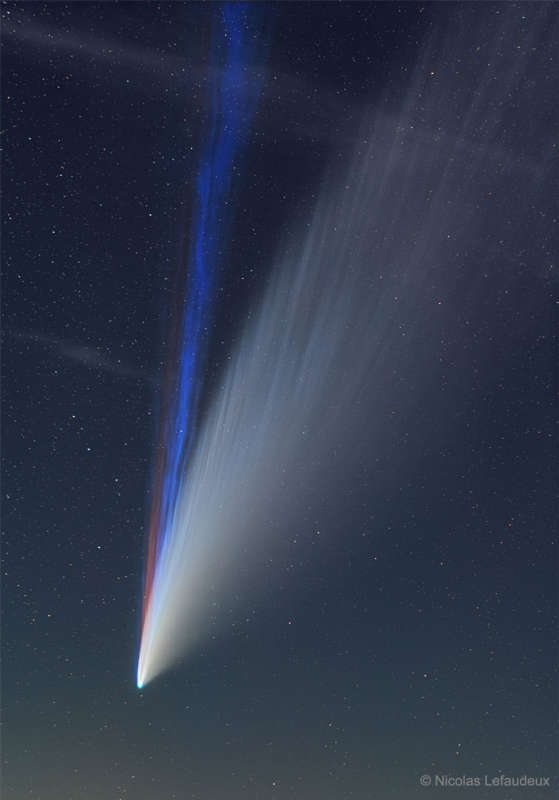Credit & Copyright: Nicolas Lefaudeux
Explanation:
What created the unusual red tail in Comet NEOWISE?
Sodium.
A spectacular sight back in the summer of 2020, Comet NEOWISE,
at times, displayed something more than just a
surprisingly
striated
white dust tail and a
pleasingly patchy blue
ion tail.
Some color sensitive
images showed an unusual red tail, and
analysis showed much of this third tail's color was emitted by sodium.
Gas rich in sodium atoms might have been liberated from
Comet NEOWISE's warming nucleus in early July by bright
sunlight, electrically charged by
ultraviolet sunlight, and then pushed out by the
solar wind.
The
featured image
was captured in mid-July from
Brittany,
France
and shows the real colors.
Sodium comet tails have been seen before but are
rare --
this one disappeared by late July.
Comet C/2020 F3 (NEOWISE)
has since faded,
lost all of its bright tails, and now approaches the orbit of
Jupiter
as it heads back to the outer
Solar System, to return only in about 7,000 years.
Astrophysicists:
Browse 2,400+ codes in the Astrophysics Source Code Library
1999 2000 2001 2002 2003 2004 2005 2006 2007 2008 2009 2010 2011 2012 2013 2014 2015 2016 2017 2018 2019 2020 2021 2022 2023 2024 2025 |
Yanvar' Fevral' Mart Aprel' Mai Iyun' Iyul' Avgust Sentyabr' Oktyabr' Noyabr' Dekabr' |
NASA Web Site Statements, Warnings, and Disclaimers
NASA Official: Jay Norris. Specific rights apply.
A service of: LHEA at NASA / GSFC
& Michigan Tech. U.
|
Publikacii s klyuchevymi slovami:
comet - komety
Publikacii so slovami: comet - komety | |
Sm. takzhe:
Vse publikacii na tu zhe temu >> | |
